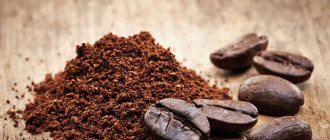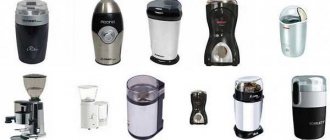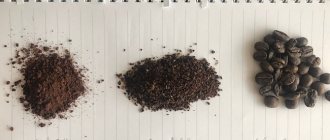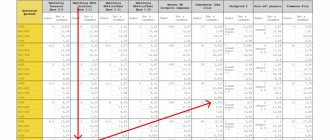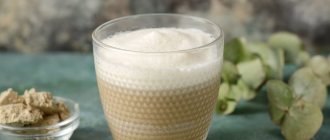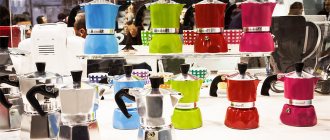Before grown, roasted coffee beans combine with water, become the basis of a magical drink and give us the incomparable joy of coffee drinking, they must be ground, i.e. crushed to a powdery free-flowing product. When buying granulated sugar in a store, we are not particularly interested in the size of the grains of sand; the product will be sweet in any case. But if you need coffee, the degree of grinding of the beans interests connoisseurs no less than its variety. The shades of coffee taste depend on it. A mistake in choice can be fatal and ruin even an expensive exclusive product. This cannot be allowed, so let’s dwell on this important topic.
Happy grinding, coffee lover!
Coffee beans are ground based on the method of preparing the drink. For each manual or automated method, there are specific types of coffee grinding. Let's start with this.
There are five main types of grinding; see their names, features and specific application in the table.
| № | Grinding name | According to international classification | Particle size of ground coffee beans | Where is it used to make coffee? |
| 1 | Large or rough | course grind | Large particles up to 0.8 mm | In French presses, geyser-type coffee makers |
| 2 | Average | medium grind | Grains the size of a fine grain of sand | Universal option, optimal for most brewing methods |
| 3 | Thin or small | fine grind | The ground mass looks like very fine sand or coarse flour | For brewing in drip coffee makers, espresso machines |
| 4 | Fine grind for espresso | fine espresso grind | Special very fine grinding made by coffee grinders built into the coffee machine | If you do this kind of grinding to brew espresso in a household carob-type coffee machine, you need to grind the beans in a coffee grinder for at least 25 seconds |
| 5 | Ultra-thin, “to dust” | pulverized | Looks like loose powder or fine flour (highest grade) | For brewing coffee in a Turk |
No matter how extensive the selection of ground coffee is, a real coffee lover would prefer to go to a specialty store, buy freshly roasted beans there and grind them at home immediately before preparing the drink. That's why every true coffee lover has his own coffee grinder, which he keeps as a relic.
How to grind coffee without a coffee grinder
You can grind the grains using a blender or food processor. Measure out the required amount of raw material and pour it into the unit. Cover with a lid and turn on medium speed. The process will take about 30 seconds.
An immersion blender will do. Place the beans in a narrow, high-sided container and insert the blender. After 30-40 minutes, the grains will be crushed to medium-sized fractions.
A rolling pin works well. Place the beans on a board, cover with a bag and grind with a rolling pin until the desired degree of grinding is achieved.
Also suitable:
- hammer;
- knife;
- mechanical meat grinder;
- a blunt, heavy object.
For instructions on the above methods, see the article “How to Grind Coffee Without a Coffee Grinder.”
How does grinding grains affect the taste?
First of all, the degree of grinding of coffee beans affects:
- on the intensity of taste;
- on the saturation and density of the drink.
80% of the taste of coffee comes from the bean. But even the pleasant sourness of high-quality Arabica can be drowned out by grinding too finely. And in the bitter variety, level out the level of bitterness by coarse grinding. Small fractions reveal all the nuances of flavor present in coffee beans, because extraction under such conditions is more intense. The total surface area of microparticles is much greater than that of grains of the same volume of a coarsely ground product. Therefore, the drink acquires richness, thickness and density. Finely ground coffee always has a fluffy and tight foam.
Coffee beans contain less than half of the total mass of valuable components soluble in water. To get a fragrant and healthy drink, you need to extract the maximum amount of coffee from the depths and transfer it to water. This process of “removal” is called extraction.
You shouldn’t get carried away with increasing the degree of grinding; each specific situation requires its individual selection. Particles that are too small are undesirable for preparing a drink in an automatic coffee machine; they will quickly clog its filters. Ultra-fine grinding is not suitable for brewing coffee in a French press; microfractions will pass through the sieve. And it is ideal for brewing in a Turk, brewing in a mug, or for a drip coffee maker.
What are the best coffee grinders?
You can create a unique drink yourself. Just buy grains and fry them. Both electrical and mechanical models are presented to everyone today. At all times, mechanical coffee grinders have been the best. It doesn’t matter that manual grinding requires a lot of effort and energy, the result will be worth it and even exceed all expectations. The quality of grinding beans with a mechanical coffee grinder is always higher. It can be purchased at a small price, which is why purchasing at this level is completely approved. You can achieve a powdery level of grinding if you use a special Turkish mill. Most often, such mills are made of copper or brass. This is the type of coffee grinder that can grind Turkish coffee to the required level. Powdered coffee ground in a Turkish mill will produce the most authentic Turkish coffee, which will not only delight, but also surprise. If you purchase an electric coffee grinder, you can afford to make preparations for brewing coffee of various levels. The main thing is to set it up correctly and you can get the raw materials for brewing the best recipes. The operating principle of an electric coffee grinder is based on the fact that the beans are crushed using knives and millstones. The degree of grinding will be determined by the operating time of the coffee grinder.
Types of household coffee grinders
This section will be useful for beginner coffee fans who have not yet acquired their own mill and buy ready-ground coffee. I do not rule out that some of the experienced “coffee makers” will want to purchase another copy in reserve or will consider it necessary to retire an old coffee grinder.
Home coffee grinders, three main types:
Knife
The coffee beans are cut into small pieces with sharp knives. The degree of grinding depends on the duration of operation of the knives. You can load from 30 g to 90 g of coffee into a knife grinder, depending on the model. There are modifications:
- with a “START” button, which is pressed and held until the end of grinding;
- with a “START” button, pressed only to turn on the unit;
- with automatic activation by closing the lid.
The advantage of knife coffee grinders is their affordable price and ease of use. These models are the most popular and best-selling. The disadvantage is the uneven grinding of the grains; the grains will always have different sizes - some will be larger, some smaller. It is impossible to regulate this process. This type of grinding will not matter if you brew coffee in a Turk, but if you need to load it into the ladle of a carob coffee machine, it is better to achieve uniform grinding.
Reference. Home coffee grinders with a rotary blade from Bosch have proven themselves to be excellent. The high speed of rotation of the knife ensures fast grinding of grains, cost from 1,500 rubles. Cheaper, more practical Polaris and Viconte units are also popular.
Millstones
Coffee grinders with metal millstones will ensure uniform grinding. The model is equipped with a regulator that will help you select and ensure the desired grinding level. Coffee grinders have up to 14 grinding levels. You can load up to 300 g of coffee at a time.
Burr grinders are considered safer than knife grinders because the grinders are located inside the unit. They cost 2–3 times more, so they are less popular.
Reference. Good burr coffee grinders cost at least 3,500 thousand rubles. The leading brands in popularity are models from De'Longhi, Nivona, and Polaris. Reliable design, choice of grinding level, high performance, and the presence of additional options (for example, a timer) are the main advantages of burr coffee grinders.
Manual
There are knife and millstone ones. Experienced coffee lovers are convinced that only with the help of such a device can they prepare beans for making real coffee. In electric coffee grinders, the beans overheat and lose some of their aroma and absorb foreign odors from plastic.
In a hand mill, the desired degree of grinding is achieved using your hands. The mood and aura of a person are conveyed to the ground grains. At the same time, monotonous movements and a stunning aroma have a beneficial effect on the “miller”, forcing him to concentrate on the process and distract from negative emotions. The psychological technique works: “And let the whole world wait...”. The only negative point that you can’t argue with is that a manual coffee grinder is uncomfortable to use at first. She does not want to lie securely in the hand and tends to slip out. This nuance is eliminated with the advent of experience and skill.
Reference. The hand mills are magnificent, made in oriental style and equipped with ceramic millstones. You can also adjust the degree of grinding and get the same grain size. Tima burr coffee grinders are very beautiful and reliable (from 2500 rubles). High-quality grinding is provided by cylindrical products from TIAMO (from 2900 rubles). The Kamille model will decorate your kitchen with a spectacular vintage look.
Arabica or Robusta - differences in taste in Turk
There are two industrial varieties of grain - Arabica and Robusta. They differ from each other in the shape of the beans, taste, and caffeine content. If Arabica in each region changes its taste characteristics depending on the type of soil, climate, and changes shades from citrus to spicy, then Robusta is less susceptible to environmental conditions.
If you brew Arabica, Robusta separately, and then a mixture of these beans in a certain proportion, you will get the following result:
- Pure Arabica has a mild taste. Depending on the variety and region of cultivation, it will have certain notes - chocolate, fruit, wine, tart. There is less caffeine in Arabica, so the rush of vivacity is felt weakly, but you can appreciate the shades of the aftertaste.
- Robusta gives bitterness. The aftertaste is slightly different, but due to the high caffeine content, a sharp surge of energy occurs and the person wakes up.
- A blend of Robusta and Arabica in a 30/70 ratio provides the optimal combination of taste and invigorating effect.
When brewing, the best ground coffee for Turkish coffee is a mixture of bean varieties; which one is better to choose in the taste rating is difficult to say right away, since coffee trees are grown in every region of the tropical belt.
To be an expert in coffee drinks, you need to try many varieties - highland, lowland. Preferably brought from abroad, and not purchased in local stores.
Automatic devices and grinding
Grinding coffee for a coffee machine has its own characteristics. In most modern devices, the grinding degree is an adjustable function. The regulator sets the level that is suitable for a specific type of coffee. Making the right choice is very important, since the type of grinding significantly affects the taste of the future drink. Coffee shop visitors can only rely on the experience and skill of the barista.
Note. If the coffee machine uses one favorite type of coffee, then the set grinding degree does not need to be changed. It is not prohibited to use it for other varieties and never switch it at all. But then the advantages of the new variety may not be fully revealed. It is undesirable to ignore the availability of switching grain grinding levels.
The time for pouring water to prepare espresso is the same, it does not depend on whether the water passes through large or dusty particles. But the taste of the drink will differ significantly; the size of the “coffee particles” affects it directly and strongly.
The volume of water poured through the thickness of the ground beans also affects the taste of coffee. An increased or decreased amount of liquid passing through particles of different grinding will change the taste of the drink in the cup. The degree of roasting will also affect it; the more intense it is, the more “bitterness” you will feel in the taste.
Devices for grinding grains
You can grind coffee using several available devices or machines. It could be:
- manual coffee grinder;
- mechanical coffee grinder;
- food processor;
- chopper
The manual option usually produces a medium grind, but it may be uneven. In addition, such a device must always sharpen the blades manually, as well as put in a lot of time and effort to get the desired powder from the grains. In addition, in this case there is no way to adjust the grinding, since there are no settings, changes or other transformations of the functional component.
A mechanical coffee grinder is designed specifically for grinding beans. Usually it contains the necessary data on the degree of grinding of coffee that can be obtained when using a specific model. Or the degree of grinding is regulated by the duration of operation of the coffee grinder, which is especially typical for earlier models. In addition, such a device usually produces a high-quality product, with uniform grinding of particles, ideal for the subsequent preparation of a flavored drink.
Using a manual coffee grinder is one of the options for grinding coffee
A food processor is not a special device for grains, but with some special attachments it can help grind grains. In this case, the quality of grinding is difficult to guarantee, and the time to obtain the powder will probably take even more than in the first case. But, on the other hand, in the absence of any other options, this one will do just fine. In addition, it will quite easily help you obtain the most universal medium grind.
You might be wondering: How many calories are in a cappuccino?
A food chopper is usually sold separately or as a package with an immersion blender. Essentially, this device is a smaller version of the food processor, so the preparation time will be similar to the previous machine. In addition, the grind obtained with the help of a grinder will be extremely coarse, since it is impossible to change the attachments in it, selecting the one you need, and the standard one is not designed to produce a powder reminiscent of flour, ideal for a coffee maker.
What grind of coffee to brew in a cup
If you don’t have a coffee maker, you can use the “Warsaw style” methods. Place the coffee powder into cups and pour boiling water. Cover with saucers and let it brew. The best, in this case, will be a fine, ordinary grind.
This is how Starbucks coffee shops brew their coffee. And they also took care of producing ultra-finely ground coffee using vacuum packaging. This marketing ploy is aimed at replacing instant coffee with ground coffee.
